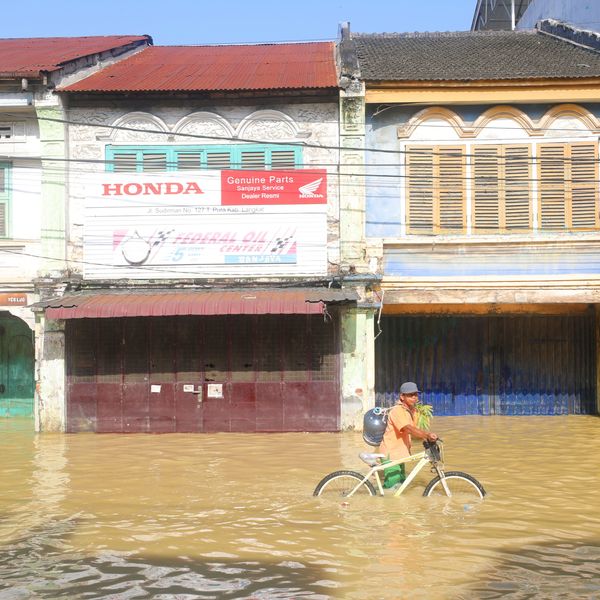India Bracing for Potentially Catastrophic Cyclone Phailin
Developing...
India is bracing for "very severe" Cyclone Phailin, a potentially catastrophic storm now barreling across the Bay of Bengal, threatening the safety of millions.

Developing...
India is bracing for "very severe" Cyclone Phailin, a potentially catastrophic storm now barreling across the Bay of Bengal, threatening the safety of millions.
Tens of thousands of people in the eastern states of Andhra Pradesh and Odisha (also referred to as Orissa) are being evacuated in preparation for the rapidly intensifying storm that has grown to half the size of India.
Winds are currently gusting as high as 190 miles per hour, and meteorologist Eric Holthaus warns that Phailin already officially reached Category 5 status. He adds:
Should the storm maintain its current strength--or strengthen even further--India could be facing a true catastrophe. A worst case scenario would have Phailin tracking slightly eastward of its current forecasted track, toward Kolkata and the Ganges Delta of Bangladesh, which is home to tens of millions of people living just a few meters above sea level.
The Indian Meteorological Department predicts Phailin will make landfall on Saturday evening, bringing with it up to 140 mile per hour winds, as much as 10 inches of rain, and storm surges of about 10 feet above normal tides, though climatologist and storm surge expert Hal Needham warns that
Phailin has the potential to generate a surge at least 6 meters (20 feet) high. This surge height would be comparable to the storm surge generated by the Galveston Hurricane of 1900. This storm devastated Galveston Island, Texas, killing between 6,000 and 8,000 people in the deadliest natural disaster in U.S. history.
Meteorologist Jeff Masters reports that "Phailin is likely to be the strongest tropical cyclone to affect India in fourteen years, since the great 1999 Odisha Cyclone" that killed over 10,000 people.
An Urgent Message From Our Co-Founder
Dear Common Dreams reader, The U.S. is on a fast track to authoritarianism like nothing I've ever seen. Meanwhile, corporate news outlets are utterly capitulating to Trump, twisting their coverage to avoid drawing his ire while lining up to stuff cash in his pockets. That's why I believe that Common Dreams is doing the best and most consequential reporting that we've ever done. Our small but mighty team is a progressive reporting powerhouse, covering the news every day that the corporate media never will. Our mission has always been simple: To inform. To inspire. And to ignite change for the common good. Now here's the key piece that I want all our readers to understand: None of this would be possible without your financial support. That's not just some fundraising cliche. It's the absolute and literal truth. We don't accept corporate advertising and never will. We don't have a paywall because we don't think people should be blocked from critical news based on their ability to pay. Everything we do is funded by the donations of readers like you. Will you donate now to help power the nonprofit, independent reporting of Common Dreams? Thank you for being a vital member of our community. Together, we can keep independent journalism alive when it’s needed most. - Craig Brown, Co-founder |

Developing...
India is bracing for "very severe" Cyclone Phailin, a potentially catastrophic storm now barreling across the Bay of Bengal, threatening the safety of millions.
Tens of thousands of people in the eastern states of Andhra Pradesh and Odisha (also referred to as Orissa) are being evacuated in preparation for the rapidly intensifying storm that has grown to half the size of India.
Winds are currently gusting as high as 190 miles per hour, and meteorologist Eric Holthaus warns that Phailin already officially reached Category 5 status. He adds:
Should the storm maintain its current strength--or strengthen even further--India could be facing a true catastrophe. A worst case scenario would have Phailin tracking slightly eastward of its current forecasted track, toward Kolkata and the Ganges Delta of Bangladesh, which is home to tens of millions of people living just a few meters above sea level.
The Indian Meteorological Department predicts Phailin will make landfall on Saturday evening, bringing with it up to 140 mile per hour winds, as much as 10 inches of rain, and storm surges of about 10 feet above normal tides, though climatologist and storm surge expert Hal Needham warns that
Phailin has the potential to generate a surge at least 6 meters (20 feet) high. This surge height would be comparable to the storm surge generated by the Galveston Hurricane of 1900. This storm devastated Galveston Island, Texas, killing between 6,000 and 8,000 people in the deadliest natural disaster in U.S. history.
Meteorologist Jeff Masters reports that "Phailin is likely to be the strongest tropical cyclone to affect India in fourteen years, since the great 1999 Odisha Cyclone" that killed over 10,000 people.

Developing...
India is bracing for "very severe" Cyclone Phailin, a potentially catastrophic storm now barreling across the Bay of Bengal, threatening the safety of millions.
Tens of thousands of people in the eastern states of Andhra Pradesh and Odisha (also referred to as Orissa) are being evacuated in preparation for the rapidly intensifying storm that has grown to half the size of India.
Winds are currently gusting as high as 190 miles per hour, and meteorologist Eric Holthaus warns that Phailin already officially reached Category 5 status. He adds:
Should the storm maintain its current strength--or strengthen even further--India could be facing a true catastrophe. A worst case scenario would have Phailin tracking slightly eastward of its current forecasted track, toward Kolkata and the Ganges Delta of Bangladesh, which is home to tens of millions of people living just a few meters above sea level.
The Indian Meteorological Department predicts Phailin will make landfall on Saturday evening, bringing with it up to 140 mile per hour winds, as much as 10 inches of rain, and storm surges of about 10 feet above normal tides, though climatologist and storm surge expert Hal Needham warns that
Phailin has the potential to generate a surge at least 6 meters (20 feet) high. This surge height would be comparable to the storm surge generated by the Galveston Hurricane of 1900. This storm devastated Galveston Island, Texas, killing between 6,000 and 8,000 people in the deadliest natural disaster in U.S. history.
Meteorologist Jeff Masters reports that "Phailin is likely to be the strongest tropical cyclone to affect India in fourteen years, since the great 1999 Odisha Cyclone" that killed over 10,000 people.

